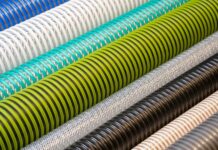
Researchers in New Zealand found that artificial hip liners made of highly-cross-linked polyethylene showed less wear 10 years after implantation than liners made of conventional ultra-high-molecular-weight polyethylene.
Patients whose hip liners were made of highly cross-linked polyethylene also had a significantly lower prevalence of osteolysis and revision surgery, according to a report in Orthopedics Today.
That’s because cross-linking ties molecules together in a lattice-like matrix, Larry Wallace, senior staff scientist at Spectrum Plastics Group, told Medical Design & Outsourcing. The structure of regular high-density polyethylene is crystalline, Wallace told us.
“It’s really good material but it isn’t chemically bonded. It’s more of physical alignment of molecules,” Wallace said of the regular polyethylene. “But on the cross-linked polyethylene, you have chemical bonding, which holds all the molecules together. Probably the reason they see the improved performance is more of dimensional stability.”
Cross-linked polyethylene has been around since the 1960s and is better known as PEX, a material used in domestic hot water pipes and as insulation for high-voltage electrical cables. Its greater dimensional stability makes it a good candidate for the wear and tear of an artificial hip, Wallace said.
Wellington Hospital orthopedic surgeon Dr. Peter Devane and colleagues randomly assigned 122 patients undergoing total hip arthroplasty for the degenerative hip disease to receive either an Enduron conventional ultra-high molecular weight polyethylene liner (UHMWPE) or a Marathon highly cross-linked polyethylene liner (XLPE). Both hip liners are made by DePuy. The researchers collected Oxford Hip Scores and general health survey scores from the 91 patients who were available for follow-up 10 years after surgery and used validated software to analyze radiographs for osteolysis and for 2-dimensional, 3-D and volumetric wear. The Oxford Hip Score is a patient-reported survey developed to assess function and pain in hip surgery patients.
The results showed a mean wear rate of 0.03mm per year for the XLPE liner group and 0.27mm per year for the UHMWPE group. The XLPE liner group also showed a significantly lower prevalence of osteolysis, pathological destruction or disappearance of bone tissue. Devane was surprised that any osteolysis had occurred with the XLPE.
“We believe the osteolysis seen with the highly [cross-linked polyethylene liner] XLPE in our study came from a premature loosening of a less than optimal cemented femoral stem,” Devane told Orthopedics Today.
Only two of the 12 revisions performed among the 91 reporting patients occurred in the XLPE group. The Oxford Hip scores and general health scores did not differ significantly among patients, regardless of the type of liner they received.
The study was limited by size, taking place at a single location and using liners made by one manufacturer. It also had the potential for underreporting of osteolysis because researchers used anteroposterior and lateral radiographs instead of CT or MRI, but Devane told Orthopedics Today that surgeons should be confident in using highly cross-linked polyethylene in total hip revision surgery.
Read more: Certain polyethylene-lined hips may last longer than others
thumbnail courtesy of medicaldesignandoutsourcing.com
Related Links:
UHMW-PE Materials and Coatings that Go One Step Beyond in Medical Design
Solvay unveils high-strength, injection-moldable PEEK polymer for medical implantables















